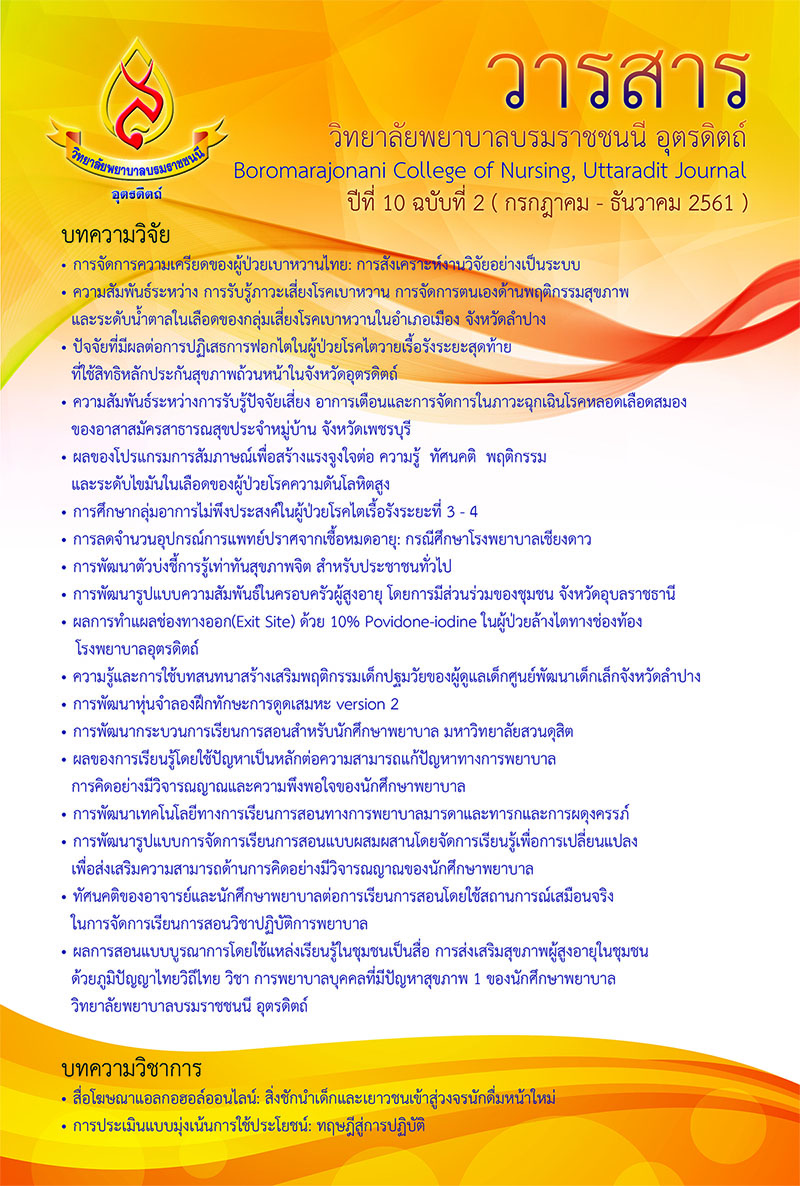ปัจจัยที่มีผลต่อการปฏิเสธการฟอกไตในผู้ป่วยโรคไตวายเรื้อรังระยะสุดท้ายที่ใช้สิทธิหลักประกันสุขภาพถ้วนหน้าในจังหวัดอุตรดิตถ์
Main Article Content
บทคัดย่อ
การปฏิเสธการฟอกไตเป็นอุปสรรคสำคัญต่อการรักษาไตวายเรื้อรังระยะสุดท้าย การศึกษาภาคตัดขวางแบบวิเคราะห์ครั้งนี้มีวัตถุประสงค์เพื่อศึกษาปัจจัยที่มีผลต่อการปฏิเสธการฟอกไต ในผู้ป่วยใช้สิทธิหลักประกันสุขภาพถ้วนหน้า จังหวัดอุตรดิตถ์ เก็บข้อมูลย้อนหลังผู้ป่วยไตวายเรื้อรังระยะสุดท้ายที่ใช้สิทธิหลักประกันสุขภาพ โรงพยาบาลอุตรดิตถ์จากเวชระเบียนและแบบการประเมินความพร้อมและคัดกรองผู้ป่วยไตวายเรื้อรังที่ 4 และ 5 ระหว่าง 1 ตุลาคม 2558 – 1 กันยายน 2560 วิเคราะห์ข้อมูลด้วยสถิติ univariable และ multivariable logistic regression
ผลการศึกษา พบว่า ผู้ป่วยไตวายเรื้อรังระยะสุดท้ายเข้าเกณฑ์ 344 ราย ปฏิเสธการฟอกไตจำนวน 138 ราย คิดเป็นร้อยละ 40.12 ปัจจัยที่มีผลการปฏิเสธการฟอกไต คือ 1) ปัจจัยที่ส่งเสริมให้ผู้ป่วยปฏิเสธการฟอกไตเพิ่มขึ้น มี 2 ปัจจัย คือ อายุมากกว่า 65ปี (AOR) = 3.00 [95% CI: 1.67-5.39], p≤ .001) อัตรากรองของไตมากกว่า 6 มล./ นาที/ 1.73 ตร.ม. (AOR=1.72 [95% CI:1.03-2.85], p≤ .037) 2) ปัจจัยที่ทำให้ปฏิเสธการฟอกไตลดลง มี 1 ปัจจัย คือ การมีผู้ดูแล (AOR=0.16 [95% CI: .07-0.38], p≤ .001)
การให้ปรึกษาการฟอกไตควรสร้างความเข้าใจให้แก่ผู้ป่วยและญาติ โดยให้ญาติผู้แลเข้ามามีส่วนร่วมตั้งแต่การให้ความรู้ความเข้าใจเรื่องโรคและแนวทางการรักษา จะทำให้ดูแลผู้ป่วยเป็นไปตามแผนการรักษา และผู้ป่วยสูงอายุมีแนวโน้มจะปฏิเสธการฟอกไตลดลง ทางทีมสหวิชาชีพควรมีจัดระบบการดูแลแบบประคับประคองให้เหมาะสม
Article Details
บทความหรือข้อคิดเห็นใดใดที่ปรากฏในวารสารวิจัยการพยาบาลและวิทยาศาสตร์สุขภาพ เป็นวรรณกรรมของผู้เขียน ซึ่งบรรณาธิการหรือสมาคมศิษย์เก่า ไม่จำเป็นต้องเห็นด้วย และบทความที่ได้รับการตีพิมพ์เผยแพร่ถือเป็นลิขสิทธิ์ของวารสารวิจัยการพยาบาลและวิทยาศาสตร์สุขภาพ
เอกสารอ้างอิง
2. Chanouzas, D., Ng, K. P., Fallouh, B., & Baharani, J. (2012). What influences patient choice of treatment modality at the pre-dialysis stage? Nephrol Dial Transplant, 27(4), 1542-1547. doi:10.1093/ndt/gfr452
3. Chiang, P. C., Hou, J. J., Jong, I. C., Hung, P. H., Hsiao, C. Y., Ma, T. L., & Hsu, Y. H. (2016). Factors associated with the choice of peritoneal dialysis in patients with end-stage renal disease. BioMed Research International, 2016, 5314719. doi:10.1155/2016/5314719
4. Cruz, D. N., Troidle, L., Danguilan, R., Padilla, B., Frando, L., Sebastian, E., . . . Finkelstein, F. (2011). Factors influencing dialysis modality for end-stage renal disease in developing countries: a survey of Filipino nephrologists. Blood Purification, 32(2),117-123. doi:10.1159/000324396
5. Dahlerus, C., Quinn, M., Messersmith, E., Lachance, L., Subramanian, L., Perry, E., . . . Tentori, F. (2016). Patient perspectives on the choice of dialysis modality: Results from the empowering patients on choices for renal replacement therapy (EPOCH-RRT) study. American Journal of Kidney Diseases, 68(6), 901-910. doi:10.1053/j.ajkd.2016.05.010
6. Department of Medical Service, Ministry of Public Health.(2018, April 24). Inspection guildeline of Ministry of Public Health 2018. Retrieved form https://inspection.dms.moph.go.th/bmss/wp-content/uploads/2017/11/InspectionGuidelineSP%E0%B8%AA%E0%B8%B2%E0%B8%82%E0%B8%B2%E0%B9%84%E0%B8%95.pdf (in Thai)
7. Fung, E., Slesnick, N., Kurella Tamura, M., & Schiller, B. (2016). A survey of views and practice patterns of dialysis medical directors toward end - of - life decision making for patients with end-stage renal disease. Journal of Palliative Medicine , 30(7), 653-660. doi:10.1177/0269216315625856
8. Harwood, L., & Clark, A. M. (2014). Dialysis modality decision-making for older adults with chronic kidney disease. The Journal of Clinical Nursing, 23(23-24), 3378-3390. doi:10.1111/jocn.12582
9. Johnston, S., & Noble, H. (2012). Factors influencing patients with stage 5 chronic kidney disease to opt for conservative management: a practitioner research study. The Journal of Clinical Nursing, 21(9-10),1215-1222. doi:10.1111/j.1365-2702.2011.04001.x
10. Just, P. M., de Charro, F. T., Tschosik, E. A., Noe, L. L., Bhattacharyya, S. K., & Riella, M. C. (2008). Reimbursement and economic factors influencing dialysis modality choice around the world. Nephrology Dialysis transplantation, 23(7), 2365-2373. doi:10.1093/ndt/gfm939
11. Kantachuwetsiri, S., Janjarerntana, V., Chailimpamontri, V., Trakarnwanit, T., Chodsenee, P., Yusabuy, A., Kingwattanakun, P. (2016). Textbook of chronic kidney disease. Bangkok: Tex and journal publication. (in Thai)
12. Kwok, W.-H., Yong, S.-P., & Kwok, O.-L. (2016). Outcomes in elderly patients with end-stage renal disease: Comparison of renal replacement therapy and conservative management. Hong Kong Journal of Nephrology, 19, 42-56. doi:https://dx.doi.org/10.1016/j.hkjn.2016.04.002
13. Liebman, S. E., Bushinsky, D. A., Dolan, J. G., & Veazie, P. (2012). Differences between dialysis modality selection and initiation. American Journal of Kidney Diseases, 59(4), 550-557. doi:10.1053/j.ajkd.2011.11.040
14. Lo, W. K., Li, F. K., Choy, C. B., Cheng, S. W., Chu, W. L., Ng, S. Y., . . . Lui, S. L. (2001). A retrospective survey of attitudes toward acceptance of peritoneal dialysis in Chinese end-stage renal failure patients in Hong Kong--from a cultural point of view. Peritoneal Dialysis International, 21 Suppl 3, S318-321.
15. Mahajan, S., Tiwari, S. C., Kalra, V., Bhowmik, D. M., & Agarwal, S. K. (2004). Factors affecting the use of peritoneal dialysis among the ESRD population in India: a single-center study. Peritoneal Dialysis International, 24(6), 538-541.
16. Moist, L. M., & Al-Jaishi, A. A. (2016). Preparation of the dialysis access in stages 4 and 5 CKD. Advances in Chronic Kidney Disease, 23(4), 270-275. doi:10.1053/j.ackd.2016.04.001
17. Morton, R. L., Snelling, P., Webster, A. C., Rose, J., Masterson, R., Johnson, D. W., & Howard, K. (2012). Dialysis modality preference of patients with CKD and family caregivers: a discrete-choice study. Advances in Chronic Kidney Disease, 60(1), 102-111. doi:10.1053/j.ajkd.2011.12.030
18. Park, J. I., Kim, M., Kim, H., An, J. N., Lee, J., Yang, S. H., . . . Lee, J. P. (2015). Not early referral but planned dialysis improves quality of life and depression in newly diagnosed end stage renal disease patients: a prospective cohort study in Korea. PLoS One, 10(2), e0117582. doi:10.1371/journal.pone.0117582
19. Ziolkowski, S., & Liebman, S. (2016). A Qualitative Assessment of Mismatch Between Dialysis Modality Selection and Initiation. Peritoneal Dialysis International, 36(4), 463-466. doi:10.3747/pdi.2015.00047


